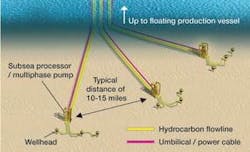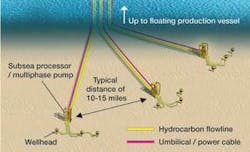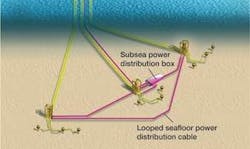Subsea architecture: the next generation
Integrated systems approach required
Mark Dixon, DeepSea Engineering & Management Inc.
Deepwater production has been an enormous technical and commercial challenge over the past few years, and a variety of solutions have been developed.
One focus has been to extend tieback distance. This primarily is governed by flow assurance requirements which are most often affected by unwanted deposition in the lines from wax, hydrate, asphaltine, and/or scale. As step-out distances increase, sufficient reservoir energy to deliver the product to the platform (or beach) becomes another key issue. Increased water depth exacerbates this concern.
For extending the tieback distance, conventional chemical and physical flow assurance prevention and remediation apply. However, the challenge of reservoir energy has encouraged development of hardware for subsea separation and artificial lift (multiphase pumping, gas lift, etc.). This equipment is changing the architecture seen in deepwater.
The deepwater tieback (and the technical and commercial issues associated with it) is important to the hub philosophy. Production levels at floating production facilities are maintained through continual development of reservoirs via tiebacks to these hubs. This usually is done by companies other than the hub operator. The latest trends in deepwater subsea architecture directed at overcoming the distance issues include:
- Subsea processing simplifies the chemistry of the product near the source by removing water to either eliminating the need for chemical treatment or to extend the distance over which the chemical cocktail is effective
- Artificial lift provides energy so reservoirs produce at flow rates necessary to justify commercial development. This also allows reservoirs with sufficient energy to be connected to host platforms at greater distances
Coverage
Subsea processing refers to any treatment of the produced fluids prior to reaching the offshore installation and conventional surface process facility. To date, subsea processing’s main focus is separation: water separation, ideally with reinjection; gas-liquid separation; and oil-gas-water separation.
Artificial lift covers any method that adds energy to the flow system via pressure boosting: gas lift/injection; multiphase pumps driven either by electrical or hydraulic (typically high pressure water) power from the platform; or ESPs (Electric Submersible pumps), several of which have been installed for North Sea applications.
One attractive and important point is that both boosting and separation can be used together, thereby providing a step change in deepwater developments.
In recent years a number of companies have advanced subsea processing and artificial lift to a mature level. However, the cost and risk trade-off with enhanced flow rate and greater well offset is a complex and difficult evaluation requiring a specific methodology.
Integrated systems approach
DeepSea Engineering & Management has an integrated approach that encompasses this emerging subsea architecture, particularly seabed processing and artificial lift, in conjunction with existing and proven options. Wherever possible, subsea processing and pressure boosting options should be considered at the earliest possible stage of the project - environmental and technological factors generally provide a schedule constraint for most applications.
For tiebacks and hub extensions, facility constraints and reservoir behavior to a large extent dictate the applicability of technologies. To overcome these constraints, the integrated systems approach must be adopted with a process able to identify and quantify the benefits, costs, and risks. As recent projects show, there rarely is opportunity for innovative technologies such as subsea processing after the first stage gate for a project. Therefore, comprehensive evaluation is required early.
Cost
By bringing processing closer to the reservoir, the need for fixed or floating platforms decreases. Even with this incentive, operators still are concerned about unforeseen costs including overcoming depth and distance issues. New technology characteristically is novel as well as complex, often relying on remote operability. The potential failure of untested, complex technology could be expensive. Also, inspection, maintenance, and repair costs for deepwater are estimates with significant uncertainty but potentially high cost.
For pressure boosting, additional hardware is in the critical path of revenue flow and is subject to the same concerns about unforeseen costs. Additionally, increased power is required to cover greater distances, and that impacts platform configuration.
System risks
Subsea processing and pressure boosting systems have physical risks:
- High voltage cables - Additional power requirements via high-voltage cables may mean surface facilities are ill equipped to support the extra demand. The cost of installing more is high. Operationally, dynamic sections of high voltage cables are unproven in the field. The installation of the first deepwater power cable is slated for the BP King project, a tieback to theMarlin TLP, which includes a dynamic section
- Hydrocarbon leaks
- Utility fluid leaks
- Power distribution/supply - These technologies require power from the platform, primarily electricity. As mentioned, deepwater, high-voltage power cables have little track record and the dynamic sections are unproven. This means either an entirely subsea distribution system with a single supply cable from the platform, or individual or looped options. The former suffers from single point failures (either in the cable or in the distribution box). The latter has increased cost and multiple dynamic sections as well as more new subsea architecture such as subsea transformers.
Correct prediction of reliability, (particularly the infant mortality rate as highlighted at the recent Subsea Tieback Forum in Galveston by Paul Hansen of Chevron), is key and perhaps represents the greatest uncertainty with new technology.
Current facilities, as well as reservoirs in which they are located, may be limited and not adaptable. Modifications might need to be made to platform, risers, and flowlines to support low-pressure production, as well as additional offshore operations to maintain new equipment. If a subsea water separation unit is needed, a water injection well also will be needed. Drilling costs could be high and reservoir restrictions may be limiting.
Way forward
DeepSea believes with such a commercial upside these technologies justify consideration on suitable projects. The main criteria are:
- Project schedule to ensure necessary qualification can be completed
- Modularized approach to the system deployment, operation, and recovery
- Installation - Weight control of deepwater processing and boosting systems is critical to installation. Use of base manifolds for in-line equipment (on which is the equipment and systems for subsea processing units) help achieve installable systems
- Need for fully understood and tested IMR procedures
As with many deepwater systems and technologies, the route to successful and commercial implementation of subsea processing and artificial lift is through initial use in shallow, less demanding water to mature the operational technology.
This process is under way - FMC Technologies has a $100-million contract from Statoil for a subsea separation, boosting and injection system for the Tordis field in the North Sea.
The road of trials and tests will pave the way for a technology set to demonstrate a major breakthrough in subsea production, and will provide the necessary technology for long-distance subsea tiebacks.
Deepwater projects in the Gulf of Mexico, Brazil, and West Africa also are considering this new generation architecture. For example the Perdido Fold area in the Gulf of Mexico has many deepwater developments owned by different operators who are considering joint development options similar to the Independence project. Chevron with the Jack project and BHP with Cascades and Chinook are examples of developments for which artificial lift systems are being considered.
In Angola blocks 18 and 31, BP has distant reservoirs which could benefit from artificial lift, even with the added complexity of inspecting, maintaining, and repairing seafloor equipment in an area with fewer offshore operations resources.
In summary, the face of subsea architecture and its mix of components and systems is changing. This started a few years ago with the introduction of subsea flow metering, and is on the verge of another step in terms of using subsea processing and artificial lift systems to extend distances between reservoirs and platforms. The economic benefits are clear, provided the development, installation, and operation of the technology are executed properly.
To achieve this, sufficient vision has to be employed at the earliest stages of project evaluation so the necessary development and qualification requirements are understood and included in the project schedule.
Additionally, getting the most from these game-changing technologies requires an integrated evaluation process, such as the one employed by DeepSea, which considers all the key items - benefit, cost, risk, CAPEX, and OPEX. Without such an integrated approach it is either extremely difficult to justify the case or quite possible to select an unworkable, and therefore expensive, solution.


